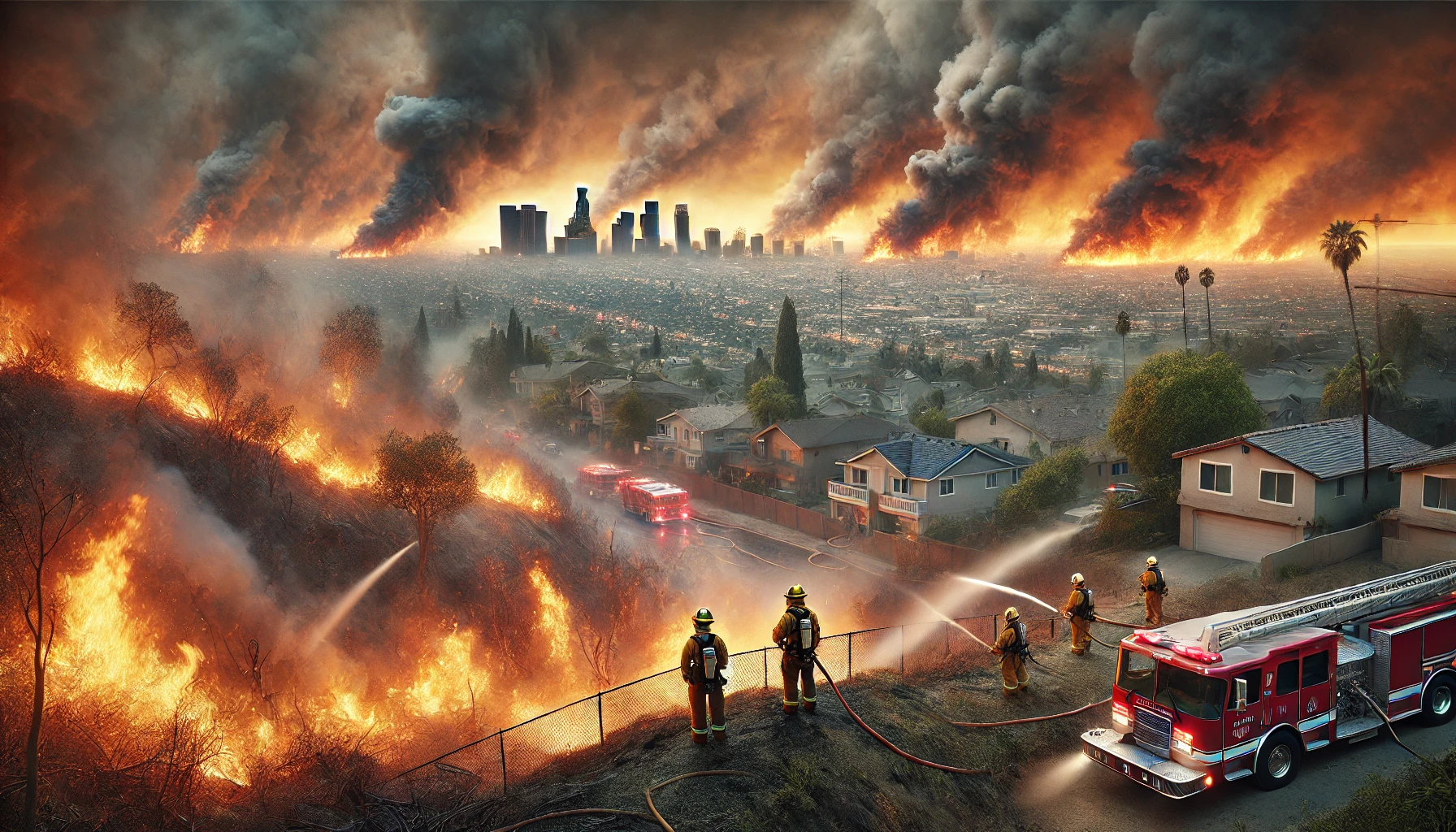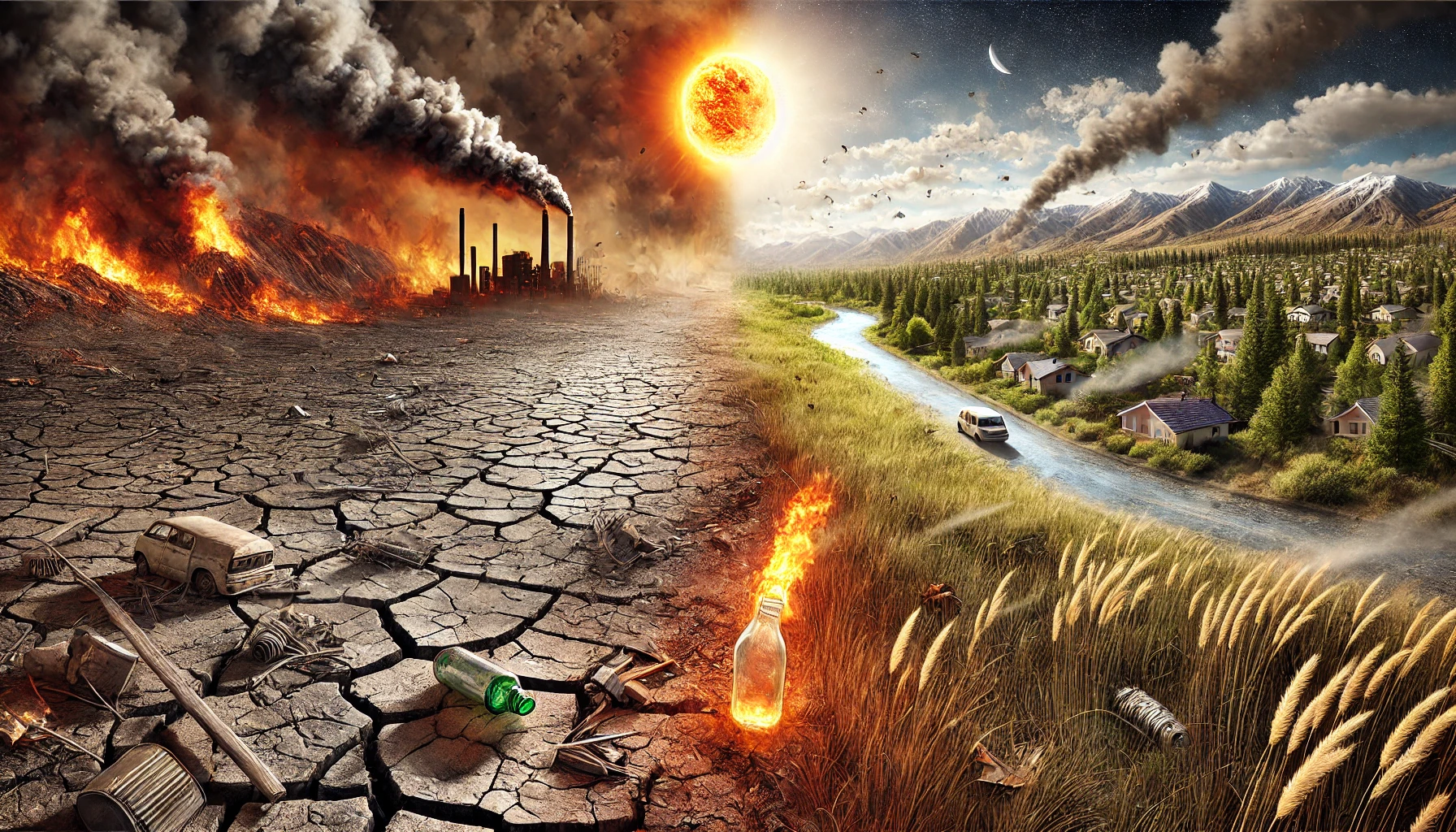
Overview of the Los Angeles Wildfires
The Los Angeles wildfires continue to be among the most devastating disasters in Southern California, leaving a significant impact on human life, property, and the environment. Spanning over 17,000 acres, these fires have caused the destruction of more than 7,000 homes and businesses, claiming 27 lives, and displacing entire communities. The scale of devastation from these LA fires has prompted widespread concern about the region’s preparedness, response, and future resilience. Environmental factors like vegetation and weather conditions significantly influence the fire intensity, affecting how these wildfires spread and the level of destruction they cause.
Key Statistics on the Los Angeles Wildfires
|
Statistic |
Details |
|---|---|
|
Acres burned |
Over 17,000 |
|
Homes/businesses damaged |
More than 7,000 |
|
Lives lost |
At least 27 |
|
Evacuations |
Over 170,000 residents |
|
Economic impact |
$52-57 billion estimated |
Santa Ana Winds and Hazardous Conditions
The Santa Ana winds and dry desert air have made the Los Angeles wildfires particularly difficult to control. These winds are known for their dry, gusty nature, which can spread flames rapidly across urban areas and open landscapes. Coupled with an abundance of dry vegetation from previous wet weather, conditions in Southern California are increasingly favorable for wildfires. Government officials play a crucial role in managing disaster response and ensuring public safety during such hazardous conditions.
Environmental Ripple Effects
The fires have:
-
Contributed to poor air quality, increasing respiratory risks for residents.
-
Destroyed critical ecosystems, affecting biodiversity in areas like the Pacific Palisades neighborhood.
-
Left behind ash and charred soil, increasing the likelihood of erosion and runoff during rainstorms.
Causes of the Wildfires

The Los Angeles wildfires result from a combination of natural factors and human influences. The Eaton Fire is an example of a significant wildfire event that has caused substantial destruction and highlights the challenges faced in managing such fires. Understanding these causes is critical for fire prevention and planning.
Natural Drivers of Wildfires
-
High Winds: Strong Santa Ana winds, which can reach speeds of over 70 mph, carried embers far from the initial fire starts, igniting new fires in areas such as Santa Monica and the West Side.
-
Prolonged Dry Conditions: Extended droughts have dried out vegetation across Los Angeles County, creating ample fuel for fires.
-
Extreme Heat: Rising temperatures in California have made the fire risk season nearly year-round, compared to the traditional summer and fall peaks.
Human Contributions
Human activity, driven by urban expansion and reliance on fossil fuels, has significantly exacerbated fire conditions:
-
Urban Sprawl: As more housing developments encroach on wildfire-prone areas, such as the Pacific Palisades neighbourhood, the risk of new fires increases.
-
Climate Change: The burning of fossil fuels contributes to climate change, which has intensified extreme weather events like heatwaves and dry winds.
Rapid Fuel Growth
The rapid growth of vegetation in Los Angeles County has significantly contributed to the wildfire crisis. In 2024, heavy rainfall linked to El Niño created lush vegetation across the region. However, this period of wet weather was followed by a dry spell, turning the abundant plant life into tinder. This phenomenon, known as “hydroclimate whiplash,” creates the perfect conditions for wildfires to spread rapidly. Globally, the risk of hydroclimate whiplash has increased by 31-66% since the mid-20th century, making regions like Southern California more vulnerable to intense fire seasons.
The Palisades Fire: A Case Study

The Pacific Palisades fire, which scorched over 17,234 acres, exemplifies the destructive power of wildfires in Los Angeles County. This fire ignited during peak fire risk conditions, spreading rapidly due to high winds and dry vegetation.
Timeline of the Palisades Fire
|
Event |
Details |
|---|---|
|
Initial spark |
Ignited in the Pacific Palisades neighborhood |
|
Rapid spread |
Grew from 10 acres to 200 acres in 25 minutes |
|
Peak size |
Reached over 17,000 acres |
|
Damage cost |
$52-57 billion |
Factors Behind Its Spread
-
Vegetation Growth: Heavy wet weather earlier in the year had encouraged the growth of grasses, which dried out during the subsequent drought.
-
Santa Ana Winds: These winds carried burning debris into densely populated areas, increasing the destruction.
Local Impact
The Palisades Fire displaced thousands of residents and disrupted daily life in Santa Monica and other parts of the West Side. Its aftermath serves as a grim reminder of the need for effective fire prevention measures.
Human Toll and Evacuations
The human impact of the LA fires is immense. Beyond the physical destruction, the fires have caused widespread emotional and social distress.
Evacuation Challenges
More than 170,000 people were forced to evacuate, often with only minutes to spare. Many residents were unable to retrieve important belongings or even pets. Emergency shelters were set up across Los Angeles County, but overcrowding and the need for medical attention created additional challenges.
Quote from a Resident:
“We left our home within five minutes of hearing the evacuation order. The flames were visible from our backyard,” said Sarah Thompson, a resident of the Pacific Palisades neighborhood. “We’re grateful for our safety, but the loss is overwhelming.”
Economic and Environmental Impacts
The economic and environmental consequences of the Los Angeles wildfires are far-reaching.
Economic Losses
The fires have severely impacted businesses and homeowners:
-
Residential Damages: Over 7,000 homes were damaged or destroyed, leaving many families without shelter.
-
Business Closures: Small businesses in areas like Santa Monica faced indefinite closures, disrupting local economies.
Environmental Degradation
The fires caused significant harm to the region’s environment:
-
Air Quality: Ash and smoke have led to hazardous breathing conditions across Los Angeles and neighboring counties.
-
Ecosystem Loss: Wildlife in Pacific Palisades and surrounding regions has been displaced, with many habitats destroyed.
Wildfire Smoke and Air Quality
The impact of wildfire smoke on air quality in Los Angeles County has been severe. The smoke from the Palisades fire and other Los Angeles wildfires has led to unhealthy air conditions, with fine particulates posing serious health risks. These particulates can penetrate deep into the lungs, increasing the risk of heart attacks and respiratory issues, and even lowering life expectancy. A study estimated that California wildfire smoke from 2008 to 2018 caused up to 55,700 premature deaths. The Los Angeles Department of Public Health has issued warnings, particularly for vulnerable groups such as children, older adults, pregnant individuals, and those with pre-existing heart or lung conditions.
Impact on Local Wildlife and Ecosystems
The Los Angeles wildfires have wreaked havoc on local wildlife and ecosystems, burning over 30,000 acres of land. This destruction has obliterated habitats, forcing many animals to flee and leaving others injured or dead. The fires have also decimated local plant species, stripping the landscape of vital vegetation. While the immediate impact is evident, the long-term consequences for local wildlife and ecosystems remain uncertain but are expected to be profound. The loss of biodiversity and the disruption of natural habitats underscore the urgent need for effective fire management and environmental protection strategies.
Response and Relief Efforts

Government Response
California Governor Gavin Newsom declared a state of emergency, enabling resources like the National Guard to assist in firefighting and evacuation efforts. The Los Angeles County Fire Department coordinated with federal agencies to deploy aircraft and additional manpower.
Community Involvement
Local nonprofits and community groups stepped up to provide food, water, and supplies to displaced residents. Fundraising initiatives have raised millions for recovery efforts.
Firefighting Challenges
Firefighters battling the Los Angeles wildfires have faced numerous obstacles. The strong Santa Ana winds have been a major challenge, fanning the flames and spreading the fires rapidly. These winds, combined with the dry desert air, have made containment efforts extremely difficult. Additionally, the fires have been burning in rugged terrain, with steep hills and canyons complicating access for firefighting crews. Limited resources have further strained efforts, necessitating collaboration with other agencies to bring in additional manpower and equipment. Despite these challenges, firefighters have shown remarkable resilience and determination in their efforts to control the blazes.
Difficult Terrain and Limited Resources
The challenging terrain of Los Angeles County has significantly hindered firefighting efforts. Steep hills and deep canyons have made it difficult for firefighters to access and combat the wildfires effectively. The Los Angeles Fire Department has had to coordinate with other agencies to bring in additional resources, including specialized equipment and extra personnel. Despite these efforts, the limited availability of resources has posed a significant challenge. Nevertheless, firefighters have made commendable progress in containing the fires, demonstrating resilience and dedication in the face of daunting conditions.
Rebuilding and Recovery
Strategies for Rebuilding
Rebuilding efforts focus on sustainability to reduce future fire risks:
-
Fire-Resistant Homes: New housing developments in Los Angeles County incorporate materials designed to withstand high heat and embers.
-
Defensible Space Regulations: Homeowners are encouraged to maintain clear areas around their properties to slow fire spread.
Fire Prevention for the Future
Efforts to prevent future disasters include:
-
Increased Firebreaks: Creating buffer zones between wildland and urban areas.
-
Education Campaigns: Teaching residents about evacuation plans and fire safety.
-
Climate Action: Reducing dependence on fossil fuels to combat climate change.
Conclusion
The Los Angeles wildfires highlight the urgent need for action on fire prevention and sustainable development. By addressing the root causes, such as climate change and urban expansion, and investing in resilience measures, Los Angeles County can protect its communities and environment from future disasters.
Relevant External Links
